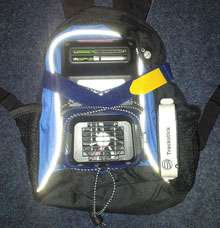New research could revolutionise the way we monitor air pollution and help us understand its effect on our health

Different people are exposed to different amounts of pollution, so current methods of using your postcode to calculate personal exposure levels could be giving inaccurate results.
Susanne Steinle, Stefan Reis and colleagues from the Centre of Ecology and Hydrology think individually tailored estimates would be more beneficial.
Currently air pollution data is gathered from 300 static sites across the UK and maps are generated by interpolating between them. People can then check their exposure levels by entering their postcode into a website.
But each site's information is only accurate for the immediate area, so if you don't have a monitoring site near your home, or if you commute long distances to work, then this data is not particularly reliable.

'How and where you spend your day is much more important than where you live,' says Dr Stefan Reis, co-author of the study. 'Studies that took a married couple who shared a home, but had different lifestyles, for example a homemaker married to a commuter, showed huge differences between their personal exposure levels.'
Commuters moving through busy stations could be inhaling particles, mostly carcinogenic diesel exhaust fumes, at levels far above the EU limit of 40 micrograms per cubic metre. Yet everyday tasks such as shaking out a duvet or cooking with a gas hob can also produce a peak of fine particles far above background pollution levels.
Since each person spends different amounts of time breathing in different levels of dangerous pollutants, it has been hard, until now, for scientists to calculate exactly what an individual is exposed to and the danger these particles pose.
A new breed of small, lightweight and portable air quality monitor has been created that offers the opportunity for monitoring exposure without impacting on a person's daily activities. Nicknamed the Jet Pack, the small backpack, includes particle monitors and a GPS. Volunteers carry it during their daily tasks such as working, cooking and commuting and the information is then collected online.
But, stock air pollution monitors are hard to use, easily break, and are too expensive for individuals to own. The team says the next stage is for scientists to develop more portable, robust and low cost tools.
'With more readily available and cheaper portable devices a citizen science programme could be set up where individuals could monitor their own exposure on a day-to-day basis' Reis says. 'The information could also be gathered in a central database to build up a near real-time picture of air pollution in a city. Such concepts are being trialled in the US and European research projects are underway as well'
This would enable researchers to build a map of pollution hot spots and could encourage better informed action from politicians to address the sources of pollution and the potential health risks they pose.
More information: Steinle S., Reis S. and Sabel C. 2013. Quantifying human exposure to air pollution - moving from static monitoring to spatio-temporally resolved personal exposure assessment. Sci. Total Environ. 443, 184-193.
Provided by PlanetEarth Online
This story is republished courtesy of Planet Earth online, a free, companion website to the award-winning magazine Planet Earth published and funded by the Natural Environment Research Council (NERC).













